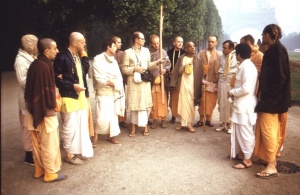CC Madhya 6.8 (1975): Difference between revisions
(Vanibot #0027: CCMirror - Mirror CC's 1996 edition to form a basis for 1975) |
(Vanibot #0020: VersionCompareLinker - added a link to the Version Compare feature) |
||
| Line 2: | Line 2: | ||
<div style="float:left">'''[[Sri Caitanya-caritamrta (1975)|Śrī Caitanya-caritāmṛta (1975)]] - [[CC Madhya (1975)|Madhya-līlā]] - [[CC Madhya 6 (1975)|Chapter 6: The Liberation of Sārvabhauma Bhaṭṭācārya]]'''</div> | <div style="float:left">'''[[Sri Caitanya-caritamrta (1975)|Śrī Caitanya-caritāmṛta (1975)]] - [[CC Madhya (1975)|Madhya-līlā]] - [[CC Madhya 6 (1975)|Chapter 6: The Liberation of Sārvabhauma Bhaṭṭācārya]]'''</div> | ||
<div style="float:right">[[File:Go-previous.png|link=CC Madhya 6.7 (1975)|Madhya-līlā 6.7]] '''[[CC Madhya 6.7 (1975)|Madhya-līlā 6.7]] - [[CC Madhya 6.9 (1975)|Madhya-līlā 6.9]]''' [[File:Go-next.png|link=CC Madhya 6.9 (1975)|Madhya-līlā 6.9]]</div> | <div style="float:right">[[File:Go-previous.png|link=CC Madhya 6.7 (1975)|Madhya-līlā 6.7]] '''[[CC Madhya 6.7 (1975)|Madhya-līlā 6.7]] - [[CC Madhya 6.9 (1975)|Madhya-līlā 6.9]]''' [[File:Go-next.png|link=CC Madhya 6.9 (1975)|Madhya-līlā 6.9]]</div> | ||
{{CompareVersions|CC|Madhya 6.8|CC 1975|CC 1996}} | |||
{{RandomImage}} | {{RandomImage}} | ||
==== TEXT 8 ==== | ==== TEXT 8 ==== | ||
| Line 11: | Line 10: | ||
<div class="verse"> | <div class="verse"> | ||
:śiṣya paḍichā-dvārā prabhu nila vahāñā | :śiṣya paḍichā-dvārā prabhu nila vahāñā | ||
:ghare | :ghare āni' pavitra sthāne rākhila śoyāñā | ||
</div> | </div> | ||
| Line 18: | Line 17: | ||
<div class="synonyms"> | <div class="synonyms"> | ||
śiṣya—disciples; paḍichā—and | śiṣya—disciples; paḍichā—and watchmen; dvārā—by means of; prabhu—Lord Śrī Caitanya Mahāprabhu; nila—brought; vahāñā—carrying; ghare—at home; āni'-bringing; pavitra—purified; sthāne—in a place; rākhila—kept; śoyāñā—lying down. | ||
</div> | </div> | ||
| Line 25: | Line 24: | ||
<div class="translation"> | <div class="translation"> | ||
While Lord Caitanya Mahāprabhu was unconscious, Sārvabhauma Bhaṭṭācārya, with the help of the | While Lord Caitanya Mahāprabhu was unconscious, Sārvabhauma Bhaṭṭācārya, with the help of the watchmen and some disciples, carried Him to his home and laid Him down in a very sanctified room | ||
</div> | </div> | ||
| Line 32: | Line 31: | ||
<div class="purport"> | <div class="purport"> | ||
At that time | At that time Sārvabhauma Bhaṭṭācārya lived on the southern side of the Jagannātha Temple. His home was practically on the beach and was known as Mārkaṇḍeya-sarastaṭa. At present it is used as the monastery of Gaṅgāmātā. | ||
</div> | </div> | ||
Latest revision as of 19:11, 27 January 2020

His Divine Grace
A.C. Bhaktivedanta Swami Prabhupada
A.C. Bhaktivedanta Swami Prabhupada
TEXT 8
- śiṣya paḍichā-dvārā prabhu nila vahāñā
- ghare āni' pavitra sthāne rākhila śoyāñā
SYNONYMS
śiṣya—disciples; paḍichā—and watchmen; dvārā—by means of; prabhu—Lord Śrī Caitanya Mahāprabhu; nila—brought; vahāñā—carrying; ghare—at home; āni'-bringing; pavitra—purified; sthāne—in a place; rākhila—kept; śoyāñā—lying down.
TRANSLATION
While Lord Caitanya Mahāprabhu was unconscious, Sārvabhauma Bhaṭṭācārya, with the help of the watchmen and some disciples, carried Him to his home and laid Him down in a very sanctified room
PURPORT
At that time Sārvabhauma Bhaṭṭācārya lived on the southern side of the Jagannātha Temple. His home was practically on the beach and was known as Mārkaṇḍeya-sarastaṭa. At present it is used as the monastery of Gaṅgāmātā.